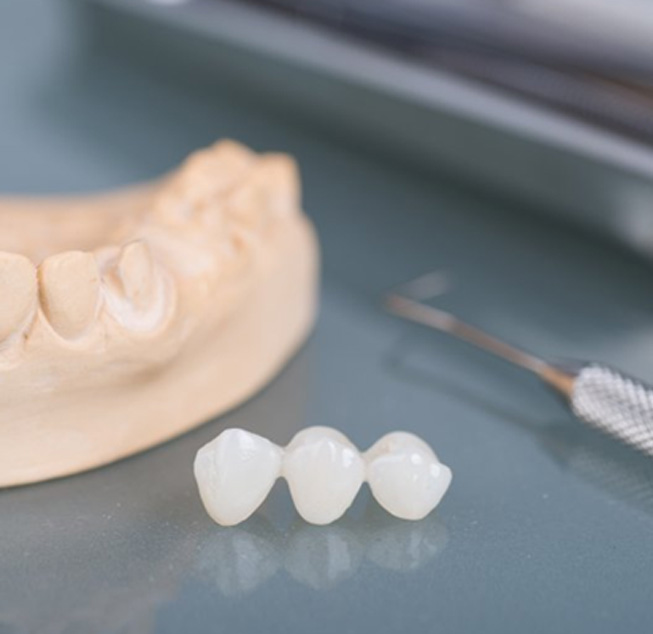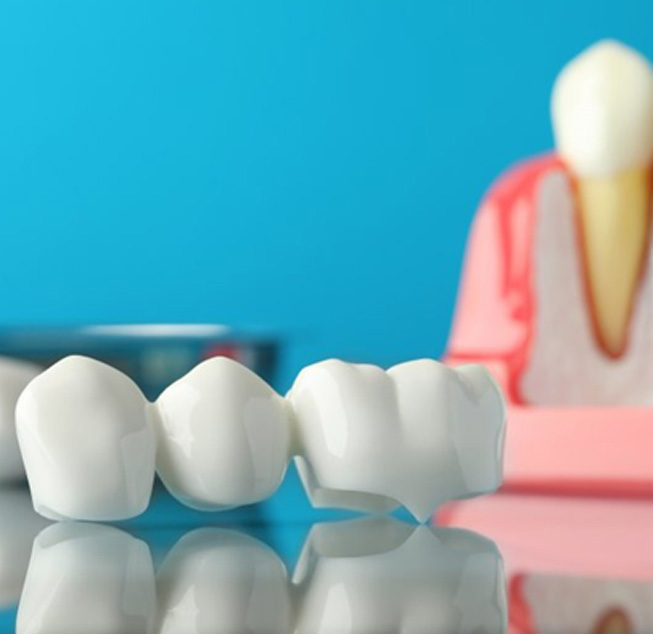Dental Bridges – Hanford, CA
Filling Your Smile Gaps with Quality Dental Work
Losing teeth can be an alarming experience, and the last thing you want to worry about is filling your smile gaps with an unaesthetic restoration. Our dental bridges are made from quality, tooth-colored materials, ensuring they’ll look like a seamless part of your grin. Whether you have one gap or several in a row, a bridge is an excellent solution for restoring your dental cosmetics and oral function!
Why Choose Hanford Family Dental Center For Dental Bridges?
- #1 No-Goop Dental Impressions With Our Digital System
- #2 Experienced And Compassionate Team
- #3 Partnered With CareCredit For Financing Options
What Is a Dental Bridge?

Picture a real bridge that’s suspended over a canyon: it has a set of supporting posts on either side of the gap, and in the middle, of course, are the planks you would travel over. A dental bridge is actually fairly similar. We’ll cap the teeth on either end of your smile gap with a crown, which will support the prosthetic teeth in the middle. This unique design is why dental bridges are perfectly suited for replacing one tooth, or several teeth that are missing in a row.
Types of Dental Bridges

We offer two kinds of dental bridges at Hanford Family Dental Center, and you can learn more about each below.
Traditional Dental Bridges
The type of bridge we first described is technically a traditional bridge. Capable of filling up to three or four gaps at a time, it’s definitely a reliable solution. However, there’s another, more modern option for patients near Hanford.
Implant Bridges
An implant bridge uses the basic design of a traditional bridge, but instead of using two crowns to anchor the restoration, we’ll attach your prosthetic teeth to dental implants. The result is an even more stable and durable restoration!
The Benefits of Getting a Dental Bridge

All of this might sound well and good, but do you really need a dental bridge? Dentists and oral experts alike agree that replacing missing teeth is better for your health and wellness. But you’d probably like more specific information! Here’s how a bridge could benefit you:
- Prevent your other teeth from drifting out of place
- Eat and speak more easily
- Brush and floss like you would for natural teeth
- Enjoy your restoration for 15+ years
- Smile brightly and confidently
Dental Bridges FAQs
Can You Take a Dental Bridge Out?
No, please don’t attempt to take your dental bridge out on your own! These restorations are designed to stay fixed in place for as long as possible. Trying to remove your bridge could harm nearby teeth, oral tissue, or ligaments.
If you’re concerned about your dental bridge or if it becomes damaged, contact our office right away. We’ll take a closer look to see whether it can be preserved and can safely remove it with our special tools if necessary.
Is Getting a Dental Bridge Painful?
For the vast majority of patients, the process of getting a dental bridge is painless. We’ll numb your mouth with a local anesthetic so that the most you’re likely to feel is some slight pressure.
If you have a history of dental sensitivity, it might be a good idea to take some OTC pain relievers an hour or two before your appointment, as well as shortly after. This way, the medicine will “stay ahead” of potential discomfort and dull unpleasant sensations.
How Long Should a Dental Bridge Last?
The average lifespan of a dental bridge is 10 to 15 years, but by taking good care of your smile, you could very well extend its longevity. Brushing and flossing your teeth every day, for example, will help you avoid cavities and gum disease, which can loosen restorations like dental bridges. You may also want to consider breaking bad oral habits such as:
- Munching on ice
- Biting your nails
- Grinding or clenching your teeth
- Smoking
These habits are known to cause premature wear for both natural and unnatural pearly whites!
How Many Teeth Can a Dental Bridge Replace?
Make no mistake, dental bridges are durable restorations, but due to simple physics, the longer they are, the less stable they can become. So there is a limit to how many teeth a dental bridge can effectively replace.
Traditional bridges can fill up to four consecutive dental gaps. Implant bridges are a bit more flexible because the implants provide extra support, and singular implants can be placed at intermittent points along the bridge to help maintain stability. They do rely on more jawbone density, though, so If you’re considering an implant bridge, we’ll carefully examine your jawbone and let you know what would be realistic.
Are Dental Bridges Safe?
Yes; dental bridges are minimally invasive and nontoxic. You generally won’t have to worry about long-lasting effects, infections, or poor reactions to our tooth-colored materials. Dental porcelain allergies and sensitivities are extremely rare, but if you do experience irritation, gum redness, or swelling near your bridge, please let us know right away.
